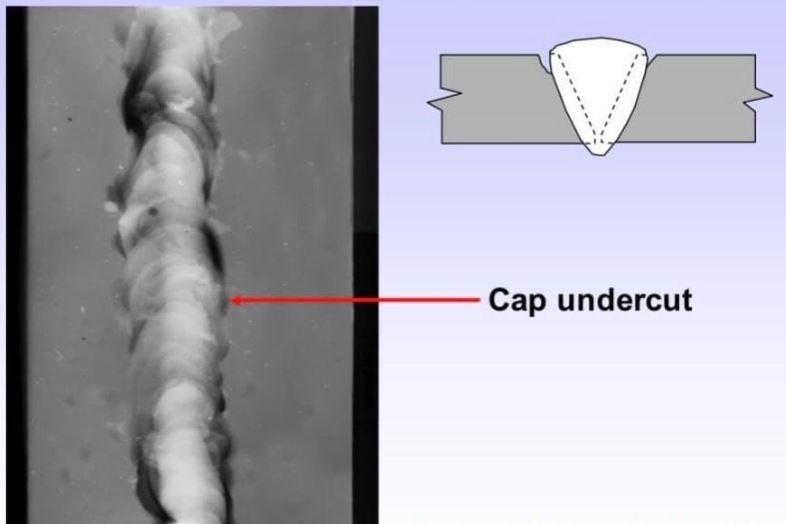How to Avoid Weld Undercut: Crucial Tips for Welders
How to Avoid Weld Undercut: Crucial Tips for Welders
Blog Article
Recognizing the Causes and Solutions for Undercut Welding in Steel Manufacture Procedures
In the world of metal construction processes, the event of undercut welding poses a significant challenge that requires a thorough understanding of its reasons and sensible remedies. The complex interaction of different aspects throughout welding operations can result in this undesirable sensation, influencing the architectural stability and overall quality of the bonded joints - Preventing weld undercut. By dissecting the origin creates of undercut welding and checking out efficient remedial actions, makers can elevate the criterion of their workmanship and guarantee the manufacturing of perfect metal parts
Common Reasons For Undercut Welding
Regularly forgotten in metal construction, undercut welding occurs as a result of different factors that require precise focus and expertise to be properly alleviated. One common reason of undercut welding is extreme heat input. When the warm input is also high, it can lead to the melting and succeeding erosion of the base product along the edges of the weld joint, creating a groove or undercut. In addition, incorrect welding strategies, such as utilizing the incorrect welding angle or travel rate, can also add to damage formation. Insufficient protecting gas insurance coverage is an additional vital aspect that can cause damaging. Not enough gas insurance coverage stops working to protect the weld pool adequately, causing oxidation and undercut defects. Additionally, the selection of welding parameters, such as voltage, present, and cable feed speed, plays a significant duty in the occurrence of undercut welding. Recognizing these common causes is vital for implementing preventive procedures and making certain top quality welds in metal construction processes.
Impact of Incorrect Welding Parameters
Imprecise welding parameters can substantially endanger the integrity and high quality of bonded joints in steel manufacture processes. The impact of wrong welding parameters shows up in various methods, leading to architectural weak points and issues in the bonded components. Meticulous interest to welding criteria is critical to make sure the manufacturing of high-grade welds with the wanted mechanical residential or commercial properties and structural integrity.
Impact of Improper Torch Angle
Improper torch angle in welding procedures can substantially affect the quality and integrity of the last weld joints in steel fabrication processes. Undercutting is an usual welding flaw where a groove forms along the weld toe, weakening the joint and endangering its architectural integrity.
A lantern angle that is as well high can bring about inadequate penetration, incomplete blend, and boosted spatter. On the other hand, a lantern angle that is as well shallow can cause extreme penetration, burn-through, and distortion of the base material. Preventing weld undercut. Correct torch angle is important for ensuring regular weld high quality, strength, and look
To avoid damaging and other defects triggered by inappropriate torch angles, welders have to be trained to maintain the right torch angle throughout the welding procedure. Regular surveillance and adjustment of lantern angles during welding can aid achieve audio welds with marginal defects.
Duty of Inadequate Welding Techniques

Another facet of poor welding strategies is incorrect weld preparation. Insufficient cleansing of the base steels, wrong joint layout, or inadequate side prep work can all add to damage welding. Insufficient shielding gas insurance coverage or making use of the wrong type of gas can result in insufficient combination and the formation of undercut issues.
To attend to the function of inadequate welding strategies in metal fabrication processes, it is necessary to give detailed training for welders. Proper education and learning on welding specifications, joint preparation, and securing gas choice can aid stop undercut welding and guarantee high-quality welds in steel construction projects.
Reliable Solutions for Undercut Welding
Dealing with undercut welding in steel construction calls for executing effective options to enhance weld high quality and architectural stability. Among the main solutions to deal with undercut is visit this web-site to adjust welding specifications such as voltage, current, and travel rate to ensure appropriate heat input and combination. By fine-tuning these setups, welders can prevent extreme melting of the base steel and filler product, reducing the probability of undercut development.
Additionally, appropriate joint prep work is essential in protecting against undercut. Ensuring clean base steel surface areas devoid of pollutants look at this site and making use of the proper bevel angle can aid promote much better weld infiltration and lower the risk of undercut - Preventing weld undercut. Employing appropriate welding methods, such as weaving or oscillating the lantern, can also help in dispersing warmth evenly and filling up the weld joint effectively, minimizing the possibility of undercut problems
Moreover, choosing the right welding consumables, consisting of electrodes and filler steels, is crucial in minimizing undercut. Using materials with appropriate chemical structures and mechanical buildings can contribute to attaining audio welds with minimal undercut. Routine examination and top quality control steps must likewise be executed to discover and address undercut problems quickly, ensuring the total stability of made steel parts.

Verdict
To conclude, recognizing the causes and options for undercut welding in steel construction processes is crucial for achieving high-quality welds. By resolving usual causes such as incorrect welding criteria, inappropriate torch angle, and insufficient welding techniques, welders can prevent damaging and guarantee strong, sturdy welds. It is important to take notice of these elements and implement reliable services to boost the general welding process and end product high quality.

Report this page